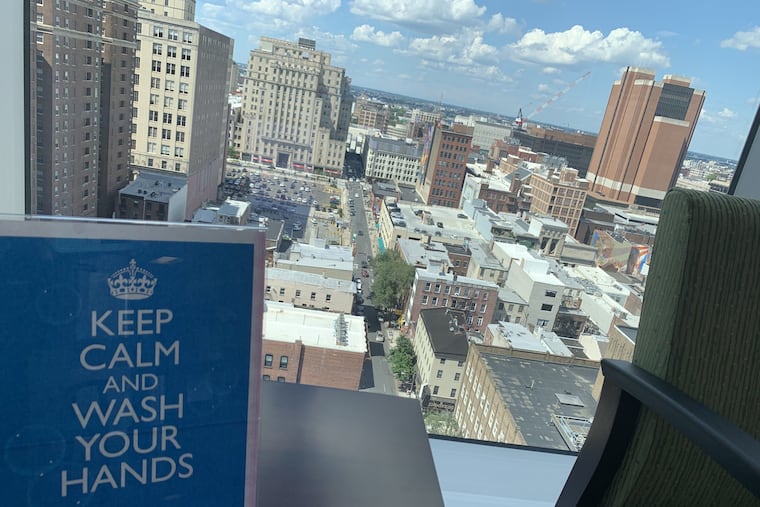The strangeness of having a checkup during a pandemic. | Maria Panaritis
The easing of COVID-19 restrictions unveils an odd, new, cautious new world order in the realm of doctor and dentist visits.

It began two weeks ago, my foray into the abnormal new normal of a region reopening from pandemic lockdown.
The kid’s dentist was back in business. My boy, too, had been yanked from kindergarten, cut off from classes, friends, and even trips to the supermarket. So, when the dental office opened back up, we slipped him in for a cleaning. In theory, schools are reopening this fall. In theory, they will need evidence that the kids saw a doctor and dentist.
His would be the first of several medical meet-ups I’d book as the region entered or moved toward the “green” phase of reopening businesses and services that were not deemed life-sustaining. What better way to kill three birds with one stone: Kid care, self-care, and journalistic curiosity?
Background about the boy: Before COVID-19 turned 2020 into a hellscape of mask-wearing vs. mask-protesting masses, before it catapulted once-forgettable Clorox wipes into a commodity rarer than gold bullion, a visit to the dentist for my kindergartner was considered on par with going to the Ocean City boardwalk.
He’d get to play on the waiting room slide and watch cartoons while reclined in a dental chair, and then he’d be told to grab a fistful of freebie toys from a basket — just for having opened wide on cue. (These are better fringe benefits, I should note, than many of us enjoy in our jobs.)
What happened instead: I opened the door to the Upper Merion dental practice waiting room and the normally buzzing place was disconcertingly quiet. The play set was cordoned off with caution tape. Waiting-room seat cushions were marked unusable with thick tape stretching the length of six feet. The boy sat next to me in a mask, motionless.
In the exam room, we saw a hygienist in a germ-fighting uniform that just about everyone wore: hair covered in a scarf; latex gloves; two masks on her face; full-body smock; plastic face shield.
MWAH-MWAH-MWAH-MWAH: The dentist, the hygienist, and I shouted and repeated ourselves as we considered the case of a trapped tooth. Our germ gear meant all three of us could manage only the muffled murmurs of the teacher from the Charlie Brown TV shows.
Chapter Two of this off-kilter odyssey continued this week in Center City for my own past-due medical visits.
The walk from Eighth and Market past Jewelers Row: This was my first time back in central Philadelphia since before the Inquirer newsroom was vacated in March. As I walked to Pennsylvania Hospital for a mammogram, I saw a smattering of boarded-up windows, shuttered dining and drinking spots, and masked pedestrians trudging through heat so intense it felt like your mask was melting onto your face.
Superficially, it seemed, it was back to business. Jewelry stores had packed their windows with diamonds, as is usually the case when they’re open. Police stood guard, as they often do in this corridor of precious gems, on the corner or Eighth and Sansom. And yet, life seemed extraordinarily still.
Inside the hospital entrance, a guard handed me a sticker and sent me to one of two nurses. I had my temperature taken and was grilled about whether I’d been traveling or had digestive problems. At radiology, lockers for storing clothes were out; green plastic bags for carrying clothes with you were in. Hand sanitizer was everywhere. The smell of disinfectant from recently scrubbed bathrooms wafted like rosewater. I crossed paths with a housekeeping staffer and wanted to give her a hug. Later, as I searched for a way out of the hospital, two incredibly gracious staffers showed me through the maze — and I spotted smiles through their masks. Could it be, that even amid the incredible strain of being a health care worker through this harrowing pandemic, people in this marvelous field were still working at peak compassion levels?
High-anxiety high-rise: After I entered the skyscraper that now houses my doctor’s office, two security guards were stationed by the elevators to limit entry to no more than four people each. A nurse took my temperature once I got off just shy of the 20th floor and asked again about potential COVID-19 symptoms, and I was soon led to an exam room.
In my doctor’s absence, I was consulted by a medical provider I’d never before met.
“What a tough year, huh?” I said, by now exhausted by the heat, the logistics, the rough year to date, and the many rough months or more ahead. I uttered the words in part as a sigh, but also as a sign of solidarity.
“I’ve seen worse,” he replied without moving his eyes from the computer into which he was typing notes about my visit. I thanked him and left.
At checkout, I saw this same man’s face and name on a placard resting on a large easel. It introduced him as new to the practice — a military man, it said, who had served as a medical officer with troops in Afghanistan.
The elevator down opened its doors. A masked woman holding an open canister of cleaning wipes hopped out — but not before first brushing her cloth across the control panel of buttons.
“Have a blessed one,” she said. And I thanked her, too.